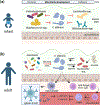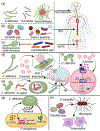Candida-bacterial cross-kingdom interactions
- PMID: 37640601
- PMCID: PMC10843858
- DOI: 10.1016/j.tim.2023.08.003
Candida-bacterial cross-kingdom interactions
Abstract
While the fungus Candida albicans is a common colonizer of healthy humans, it is also responsible for mucosal infections and severe invasive disease. Understanding the mechanisms that allow C. albicans to exist as both a benign commensal and as an invasive pathogen have been the focus of numerous studies, and recent findings indicate an important role for cross-kingdom interactions on C. albicans biology. This review highlights how C. albicans-bacteria interactions influence healthy polymicrobial community structure, host immune responses, microbial pathogenesis, and how dysbiosis may lead to C. albicans infection. Finally, we discuss how cross-kingdom interactions represent an opportunity to identify new antivirulence compounds that target fungal infections.
Keywords: Candida albicans; antifungal immunity; cross-kingdom interactions; polymicrobial infection.
Copyright © 2023 Elsevier Ltd. All rights reserved.
Conflict of interest statement
Declaration of interests No interests are declared.
Figures



Similar articles
-
Metabolic Adaptations During Staphylococcus aureus and Candida albicans Co-Infection.Front Immunol. 2021 Dec 8;12:797550. doi: 10.3389/fimmu.2021.797550. eCollection 2021. Front Immunol. 2021. PMID: 34956233 Free PMC article. Review.
-
Candida-Bacteria Interactions: Their Impact on Human Disease.Microbiol Spectr. 2016 Jun;4(3). doi: 10.1128/microbiolspec.VMBF-0030-2016. Microbiol Spectr. 2016. PMID: 27337476 Review.
-
Candida-Bacterial Biofilms and Host-Microbe Interactions in Oral Diseases.Adv Exp Med Biol. 2019;1197:119-141. doi: 10.1007/978-3-030-28524-1_10. Adv Exp Med Biol. 2019. PMID: 31732939 Review.
-
Commensal Protection of Staphylococcus aureus against Antimicrobials by Candida albicans Biofilm Matrix.mBio. 2016 Oct 11;7(5):e01365-16. doi: 10.1128/mBio.01365-16. mBio. 2016. PMID: 27729510 Free PMC article.
-
Cross-kingdom interactions: Candida albicans and bacteria.FEMS Microbiol Lett. 2009 Oct;299(1):1-8. doi: 10.1111/j.1574-6968.2009.01668.x. Epub 2009 Jun 3. FEMS Microbiol Lett. 2009. PMID: 19552706 Free PMC article. Review.
Cited by
-
Surface-Charge Tuned Polymeric Nanoemulsions for Carvacrol Delivery in Interkingdom Biofilms.ACS Appl Mater Interfaces. 2024 Jul 24;16(29):37613-37622. doi: 10.1021/acsami.4c06618. Epub 2024 Jul 15. ACS Appl Mater Interfaces. 2024. PMID: 39007413 Free PMC article.
-
Lower gastrointestinal tract dysbiosis in persistent critical illness: a systematic review.J Med Microbiol. 2024 Oct;73(10):001888. doi: 10.1099/jmm.0.001888. J Med Microbiol. 2024. PMID: 39383061
-
Aspirin Combined with Antifungal Drugs Suppresses Candida albicans Biofilm by Activating Autophagy.J Microbiol Biotechnol. 2025 Mar 27;35:e2411060. doi: 10.4014/jmb.2411.11060. J Microbiol Biotechnol. 2025. PMID: 40147925 Free PMC article.
-
A fungal metabolic regulator underlies infectious synergism during Candida albicans-Staphylococcus aureus intra-abdominal co-infection.Nat Commun. 2024 Jul 9;15(1):5746. doi: 10.1038/s41467-024-50058-w. Nat Commun. 2024. PMID: 38982056 Free PMC article.
-
Study on the effect of chlorogenic acid on the antimicrobial effect, physical properties and model accuracy of alginate impression materials.PeerJ. 2024 Oct 31;12:e18228. doi: 10.7717/peerj.18228. eCollection 2024. PeerJ. 2024. PMID: 39494305 Free PMC article.
References
-
- WHO fungal priority pathogens list to guide research, development and public health action. Geneva: World Health Organization; 2022. Licence: CC BY-NC-SA 3.0 IGO.
Publication types
MeSH terms
Grants and funding
LinkOut - more resources
Full Text Sources

